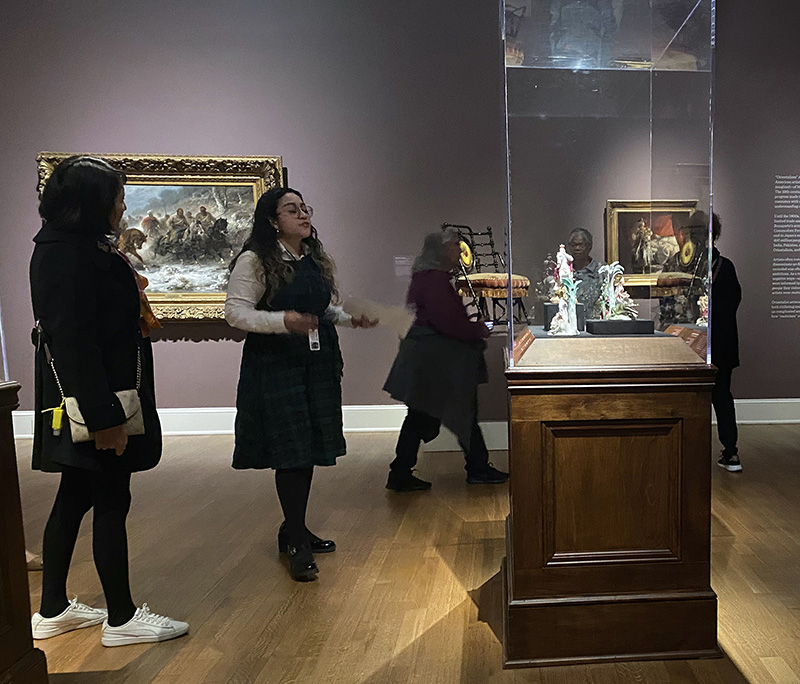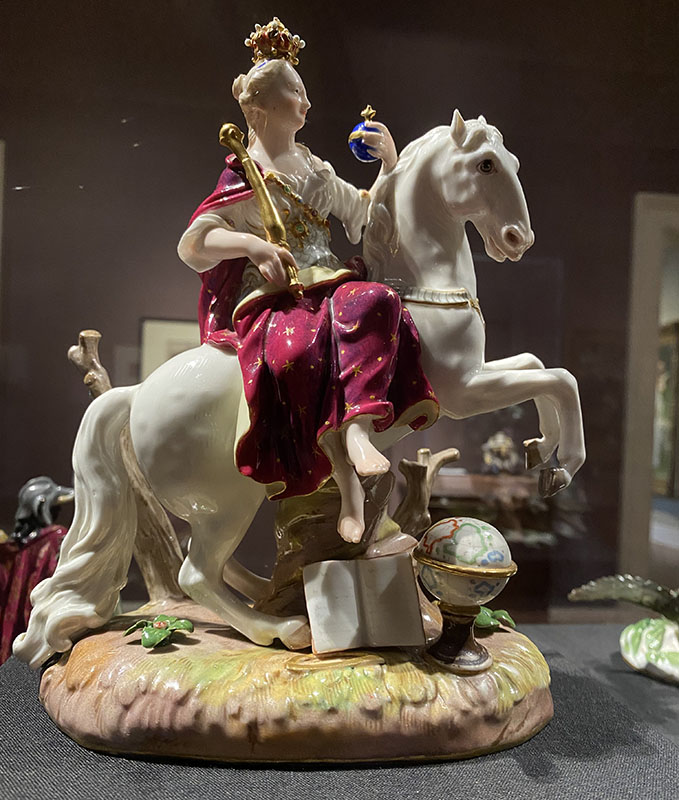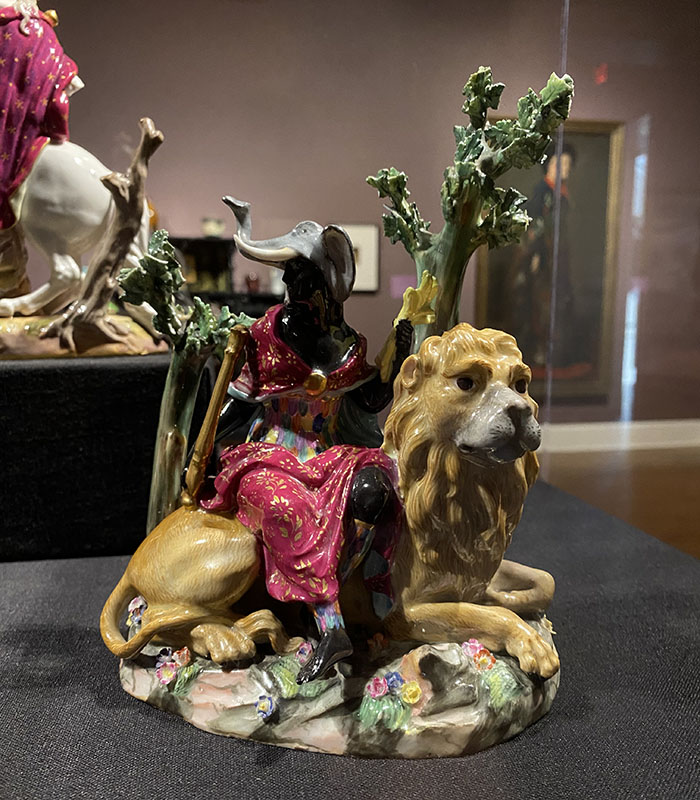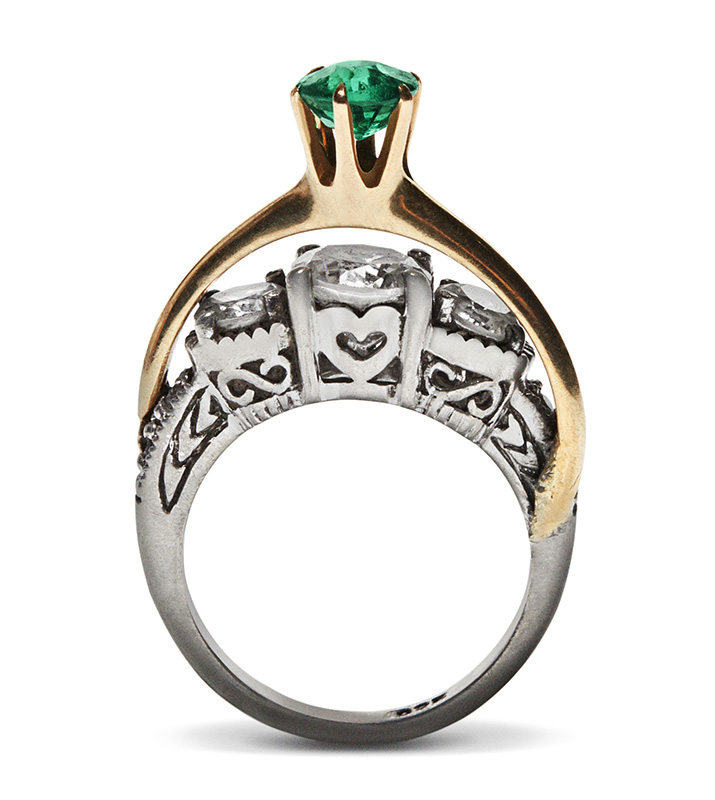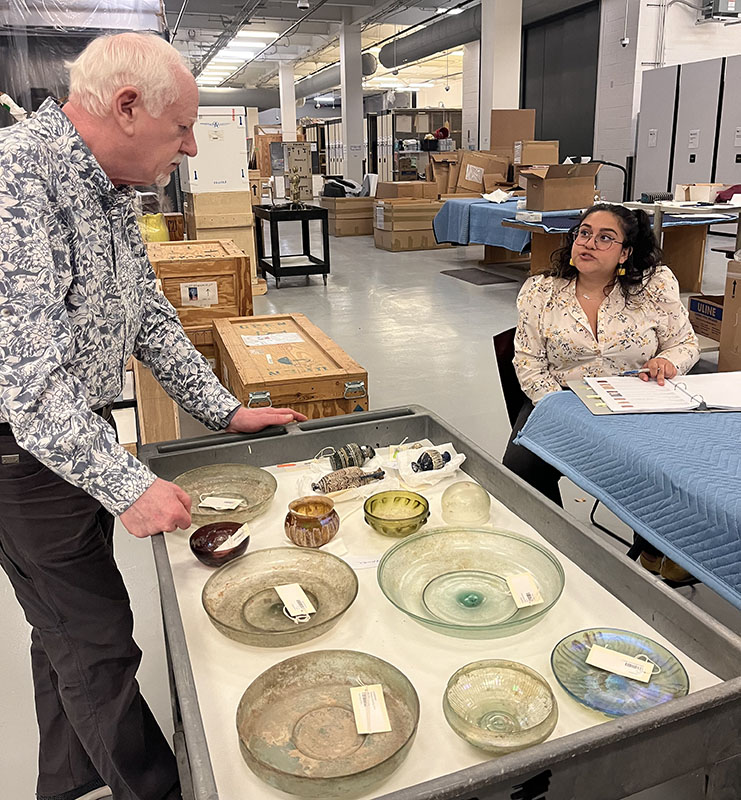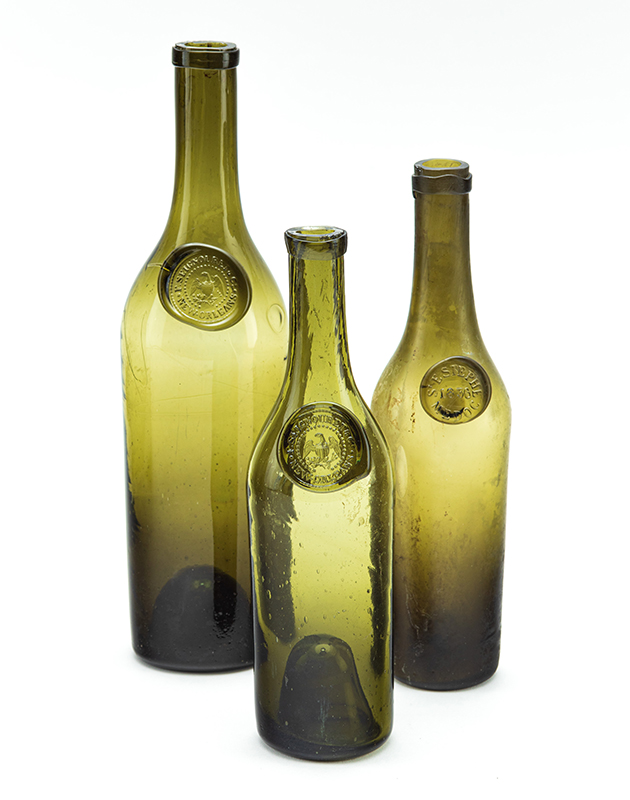A Million Hidden Stories: Uncovering Materials at the New Orleans Museum of Art
by Laura Ochoa Rincon
Thanks to the generosity of the Decorative Arts Trust, I enjoy the opportunity to work at the New Orleans Museum of Art (NOMA) on a Curatorial Fellowship. In August 2022, I joined Mel Buchanan, NOMA’s RosaMary Curator of Decorative Arts & Design, for a two-year stint exploring a wide-ranging collection, with an emphasis on researching the museum’s glass holdings.
One of my first opportunities to share research to the museum community was a gallery talk, a short 15-minute discussion given by NOMA staff about works of art (figure 1). As nervous as I was, I led an intriguing discussion about four Meissen Factory porcelain figures, allegorical symbols of the four continents. Originally designed c. 1746 by Meissen’s famous sculptor Johann Joachim Kaendler, these representations of Africa, America, Asia, and Europe reveal how Europeans perceived their explorations of distant cultures and the so-called “new world”—though we know now that none of this world was “new” to those who had been living there for thousands of years! This allegory of the continents was derived from a 16th-century Flemish folio that was brazen in its reductive depiction of the continents. Europe (figure 2) towers above all others, on top of a striking white horse holding an orb of knowledge and clothed in fine and rich regalia. The depiction of Africa (figure 3) was not fully clothed and adorned with only those elements that Europeans viewed as valuable resources.
In my talk, I emphasized that designers and makers often exoticized other cultures and that bled heavily into Europe’s understanding of a globalizing world. I was surprised when a museum visitor came up to me after the presentation and told me the story of how she had seen these figures in a home where she worked as a maid. She shared that the figures would often conjure up negative emotions for her, and having now learned the history, she felt justified in that discomfort. Hearing and internalizing her story made me realize how critical it is to confront and publicly share hard truths about the history of design motifs in decorative arts.
In May, NOMA opened The Susan Grant Lewin Collection, an exhibition developed in partnership with the Savannah College of Art & Design. I was able to take a role in coordinating the installation. This fascinating show, featuring 97 rings from designers of the post WWII period, showed me the ins and outs of what it takes to present a museum show. I planned the layout, gave talks, trained docents, and even spoke to the local press. Through the show I had my first experience with the process of museum shipping arrangements, conservation planning, communicating needs for graphic design, and the teamwork behind an installation, but it also opened up an entire era of craft and design that I had only known about through small glimpses at previous internships. One ring in particular, Second Wife by Davis Russel Kemp (American, b. 1996) kept me amused, and its humor deeply illustrated the innate symbolism of rings and their storytelling power (figure 4). Consisting of a cubic zirconia and silver ring (the first engagement ring) topped by a gold and emerald ring (the second engagement ring), the ring illustrates a story: one of an earlier-in-life marriage, and an upgraded ring given to a second wife. Rings are now and have been historically a deep and visceral representation of love, compromise, and commitment.
The main focus of my two-year fellowship at the New Orleans Museum of Art is a fall 2024 exhibition and catalog of NOMA’s collection of glass. As an optimistic young scholar fresh out of grad school, having never really worked specifically with the medium of glass, I was frankly intimidated. Our first objective was to assess the wide-ranging collection with the help of outside scholars (figure 5). The chance to collaborate with these experts gave me a sense of confidence over the project, and I learned a tremendous amount. We sharpened our connoisseurial skills looking closely at Sidonian mold-blown glass, air-twist stem goblets, lily-pad pitchers, and silvered “mercury” glass, but I was particularly grateful for the chance to discuss the hidden stories that can be pulled out of these objects with Mel Buchanan, NOMA’s Objects Conservator Ingrid Seyb, and the visiting scholars. Through those collaborative moments, we began to see the formation of the catalog and all the narratives to be shared.
I took this newfound passion for glass to other assignments, including an article for the local Times-Picayune newspaper about some outstanding wine glass bottles from New Orleans (figure 6). These bottles were made in a sizable French glass manufactory owned by famed New Orleans furniture retailer and businessman Francois Seignouret (French, active New Orleans, 1783–1852), which sat alongside his vineyard in Bordeaux. Seignouret brought French furniture and wine to New Orleans, carefully labeling everything, including these bottles, with his name. The bottles exemplify a centuries-long connection to France while concurrently telling an important story about the importance of wine to the city.
I have also been exploring an 1850s Bohemian glass goblet showing New Orleans (figure 7). Seemingly a rose-colored souvenir meant to evoke rosy memories, the engraved cityscape contains deeper stories. The goblet proudly features both the city’s iconic St. Louis Cathedral and the St. Charles Hotel (built 1837, burned 1851). Many of the laborers responsible for erecting these iconic structures were enslaved, their hands laying the bricks, molding the ironwork, and crafting the intricate plaster details that adorned these landmarks. The elegant St. Charles was a site for the auction of enslaved people at the time this goblet was made. Research reveals that the stories of these people, which history has sometimes occluded, are quite literally etched into the glass. It is because of objects like this that I am now so fervent about glass and its storytelling possibilities.
This summer, NOMA presented Fashioning America: Grit to Glamour (figure 8), an exhibition organized by the Crystal Bridges Museum of American Art. Again, I was both intrigued and slightly worried by the opportunity to contribute to this project, as it was another area where I had little experience aside from a six-week textile block in the Winterthur Program in American Material Culture, during which we did not cover Air Jordan sneakers, Levi’s jeans, or 1950s metallic thread swimsuits! My specific contribution to this project was to engage with the bilingual presentation in Spanish and English, to enable a whole new audience to experience all the beautiful stories in this show. I have been able to give tours of the exhibition in Spanish and made sure that NOMA’s content for both marketing and all of the exhibition labels capture the nuance of Spanish language properly. One of our stumbling blocks was working with the translation of the title Grit to Glamour. Those words and alliteration are catchy and meaningful in English, but a direct translation (de la rudeza al glamour) is akin to “Gore to Glamour” so fellow Spanish speakers on staff and I suggested the title “De la Firmeza al Glamour,” to better capture the intended gumption and spirit. This project was a labor of love as well as a use of my material culture and language skills. Growing up with parents who do not speak English, I was always having to translate to my Colombian parents whenever we went to museums. By sharing this show in Spanish, visitors like my parents can experience the show to its fullest extent—without the inherent barrier of language. This gift to them and my community is perhaps my proudest accomplishment during my time at NOMA.
Thanks to my Decorative Arts Trust Curatorial Fellowship, I have learned an extraordinary amount in my first year about glass, rings, fashion, and how all of these different objects are ways to convey stories about people. I have been able to sit at the table as a member of the museum’s curatorial department, and my growth as a curator has been remarkable. As much as Mel Buchanan and the New Orleans Museum of Art team has given me in opportunities and guidance, I hope I am able to give back to them in enthusiasm, probing questions, and engaged research that helps to pull stories from the historical margins.
Laura Ochoa Rincon is the Decorative Arts Trust Curatorial Fellow at the New Orleans Museum of Art.
A print version of this article was published in The Magazine of the Decorative Arts Trust, one of our most popular member benefits. Join today!

